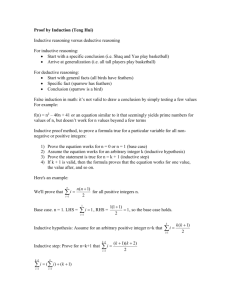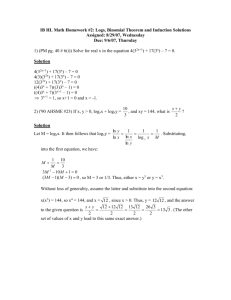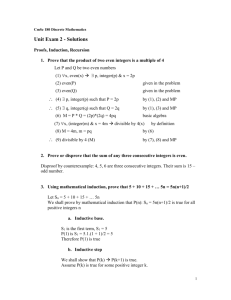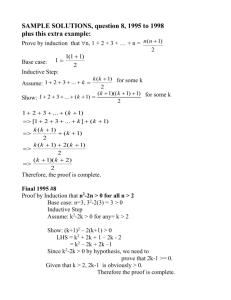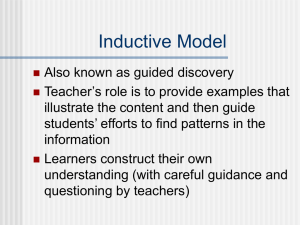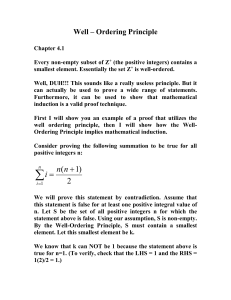Written
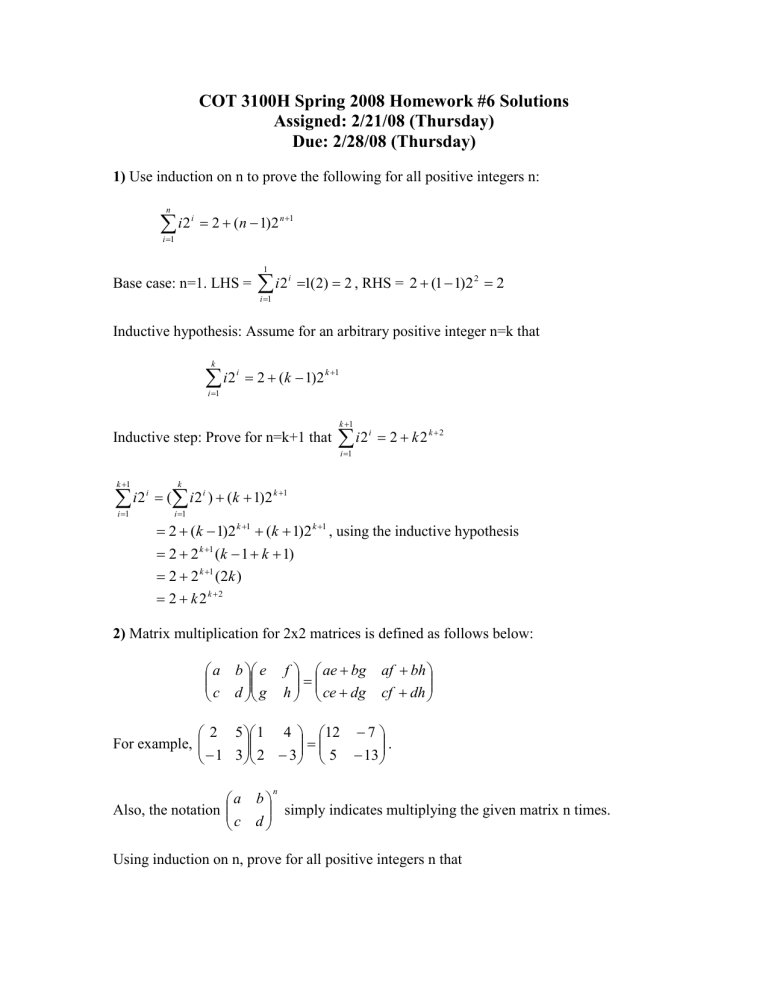
COT 3100H Spring 2008 Homework #6 Solutions
Assigned: 2/21/08 (Thursday)
Due: 2/28/08 (Thursday)
1) Use induction on n to prove the following for all positive integers n: i n
1 i 2 i
2
( n
1 ) 2 n
1
Base case: n=1. LHS =
1 i
1 i 2 i
1 ( 2 )
2 , RHS = 2
( 1
1 ) 2
2
2
Inductive hypothesis: Assume for an arbitrary positive integer n=k that i k
1 i 2 i
2
( k
1 ) 2 k
1
Inductive step: Prove for n=k+1 that i
1 k
1 i 2 i
2
k 2 k
2 k i
1
1 i i k
2
(
i
1 i 2 i )
2
( k
( k
1 ) 2 k
1
1 ) 2 k
1
( k
1 ) 2 k
1
, using the inductive hypothesis
2
2 k
1
( k
1
k
2
2 k
1
( 2 k )
1 )
2
k 2 k
2
2) Matrix multiplication for 2x2 matrices is defined as follows below:
a c b d
e g f h
ae ce
bg dg af cf
bh dh
For example,
2
1
5
3
1
2
4
3
12
5
7
13
.
Also, the notation
a c b d
n
simply indicates multiplying the given matrix n times.
Using induction on n, prove for all positive integers n that
2
1
1
0
n
n
1 n
Base case: n=1. LHS =
2
1
n n
1
1
0
1
2
1
1
0
, RHS =
1
1
1 1
1
1
2
1
Inductive hypothesis: Assume for an arbitrary positive integer n = k that
2
1
1
0
k
k
1 k
k k
1
Inductive step: Prove for n = k + 1 that
2
1
1
0
k
1
k k
2
1 k
k
1
2
1
1
0
k
1
2
1
k k
2
1
1
0
k
2
1
1
0
k
1 k
k k
1
2
1
2
( k
2 k
1 ) k
k
1 k
k
1
1
0
k
k
1
, as desired, proving the claim for all positive
1
0
integers n.
3) Using induction on n, prove that 7 | (3
2n+1
+ 2 n+2
) for all integers n
0.
Base case: n = 0. 3
2(0)+1
+ 2
0+2
= 3 + 4 = 7, which is divisible by 7, so the base
case is true.
Inductive hypothesis: Assume for an arbitrary non-negative integer n = k that
7|(3
2k+1
+2 k+2
). Namely, there exists an integer c such that 3
2k+1
+2 k+2
= 7c.
Inductive step: Prove for n = k +1 that 7|(3
2(k+1)+1
+2 k+3
).
3 2(k+1)+1 +2 k+3 = 3 2k+3 +2 k+3
=3
2k+1
3
2
+2 k+2
(2)
= (9)3
2k+1
+(2)2 k+2
= (7)3
2k+1
= (7)3
2k+1
+ (2)3
+ 2(3
2k+1
+ (2)2
2k+1
+ 2 k+2
) k+2
= (7)3
2k+1
+ 2(7c), using the inductive hypothesis
= 7(3 2k+1 + 2c), which completes the proof since c and k are integers.
4) Consider a sequence of numbers defined as follows:
t(0) = 1, t(1) = 4, t(n) = 5t(n-1)-6t(n-2), for all integers n > 1.
Using strong induction on n, prove for all non-negative integers n
that t(n) = -2 n + 2(3) n .
Base cases: n=0. LHS = t(0) = 1, RHS = -2
0
+ 2(3)
0
= -1 + 2 = 1
n=1. LHS = t(1) = 4, RHS = -2
1
+ 2(3)
1
= -2 + 6 = 4
Inductive hypothesis: Assume for all non-negative integers n ≤ k, where k is an arbitrarily chosen positive integer, that t(n) = -2 n
+ 2(3) n
.
Inductive step: Prove for n = k+1 that t(k+1) = -2 k+1
+ 2(3) k+1
. t(k+1) = 5t(k) – 6t(k-1)
= 5(-2 k
+ 2(3) k
) – 6(-2 k-1
+ 2(3) k-1
), plugging into the I.H. twice.
= -5(2 k
) + 10(3 k
) + 6(2 k-1
) – 12(3 k-1
)
= -5(2 k
) + 10(3 k
) + 3(2 k
) – 4(3 k
)
= -2(2 k
) + 6(3 k
)
= -(2 k+1
) + 2(3 k+1
)
5) Assuming the product rule for derivatives ( d dx
( uv )
u dv dx
v du dx
) and the basic information that d dx
( x
1
)
1 , prove the power rule, d dx
( x n
)
nx n
1
, for all positive integers x. (If you haven't had Calculus, you can skip this question.)
Base case: n=1. LHS = d dx
( x
1
)
1 , RHS = 1 x
1
1
1
Inductive hypothesis: Assume for an arbitrary integer n = k that d dx
( x k
)
kx k
1
.
Inductive step: Prove for n = k+1 that d dx
( x k
1
)
( k
1 ) x k d dx
( x k
1 )
d dx
( x k x )
x k d dx x k
( 1 )
( x )
x d dx x ( kx k
1
)
( x k ) ,using the product rule
, using the inductive hypothesis
x k kx k
( k
1 ) x k
, as desired.

